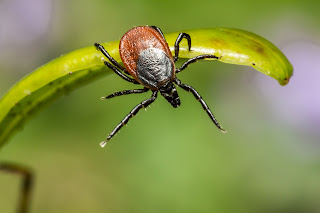How to protect yourself from ticks
Ticks can transmit Lyme borreliosis and TBE to humans. Our occupational doctor explains how to protect yourself from the bites of these parasites.
Tick bites in Switzerland lead to around 10,000 visits to the doctor every year. These bites are considered to be an accident and cost millions of francs. Ticks can transmit Lyme borreliosis or TBE (spring-summer meningoencephalitis) to humans. Although there is no total protection against the diseases transmitted by these parasites, with a few simple precautions it is still possible to reduce the chances of being bitten.
Protect yourself from tick bites
- Above 8 degrees Celsius, avoid places where it is possible to come into contact with ticks: edges of woods and paths, bushes, foliage, scrub and undergrowth, meadows and ferns up to 1.5 m above the ground and at altitudes up to 2000 m.
- Wear light-coloured closed clothing that covers as much of the body as possible. Ticks are easier to spot on light-coloured clothing. This way they can be removed before they reach the skin and sting.
- Spray your skin and clothing with a tick repellent product.
- Remove ticks: Grasp the tick as close to the skin as possible with pointed tweezers or special tick forceps and pull it upwards, then disinfect the wound.
- The Federal Office of Public Health recommends getting vaccinated by your family doctor or pharmacy.
- Tick bites are considered to be an accident and the cost of treatment is borne by the accident insurance.
Felix Ineichen, ticks are particularly active in spring. What is the best way to defend against the bites of these parasites?
Felix Ineichen: After being in the woods or on the lawn you have to check that there are no ticks on the body, especially in the crook of the knees, in the groin or in the armpits. When you go to the woods, it is advisable to wear tight-fitting, light-coloured clothes, as this makes it easier to discover ticks and remove them before they can sting. It is also recommended that you spray an anti-tick spray on your skin and clothing.
Why are ticks dangerous?
Viral infection can cause inflammation of the meninges and lead, albeit in rare cases, to severe damage to the brain or spinal cord. Unlike TBE, borreliosis is quite common and causes inflammation of the skin, joints, heart and/or nervous system. A little known disease transmitted to humans by a tick bite is rabbit fever, known medically as tularemia.
When and why can rabbit fever be very dangerous?
Infection, caused by the bacterium Francisella tularensis, can occur through inhalation or ingestion. Especially hunters and gamekeepers are exposed to danger because they are in direct contact with wild animals. But even foresters can become infected, for example, if they inhale dust contaminated by the feces or corpses of infected animals. For this reason, all necessary precautions must be taken when working on lawns, slopes or undergrowth. The risk of becoming infected is particularly high when using the brush cutter or blower. In these situations, it is recommended to protect yourself with a dust mask.
How useful is the so-called rapid test to understand if the tick is a carrier of diseases?
The percentage of ticks carrying Borrelia, that is bacteria that cause diseases in humans, is limited and varies from 5 to 50 per cent. Furthermore, borrelia is only transmitted if the tick has been sucking blood for a few hours. Therefore, in many cases, there is no need to take the test. And let's not forget that, even if the tick is not a carrier of the pathogen, the infection may have been transmitted from a previous bite, which went unnoticed. Also of this opinion is the National Reference Center for Tick-borne Diseases (NRZK), which in fact does not recommend the rapid test.
In addition to the rapid tick test, what other protective measures are in place in Switzerland?
Among the various measures adopted in the forestry sector, there is also that of wearing protective clothing treated with an anti-tick liquid. The active ingredient (permethrin) has been used for some time in various fields, including in insecticide sprays. It can be absorbed through the skin and it is unclear whether it has a carcinogenic effect. Therefore, the pros and cons in terms of protection against tick bites and permethrin exposure should be carefully weighed.



Comments
Post a Comment